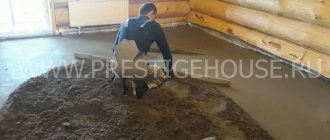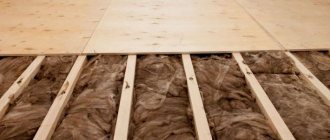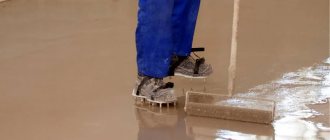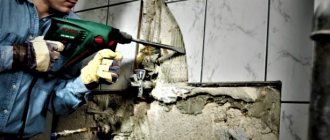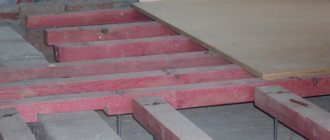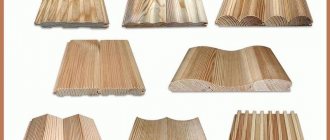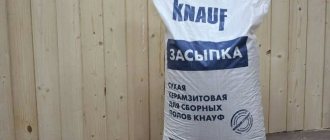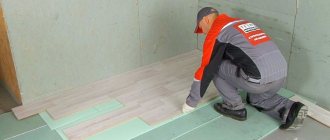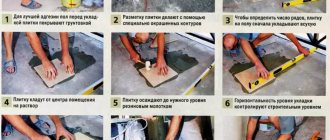As a rule, most of the newest floor coverings place significant demands on the sub-base of a wood or concrete floor. For this reason, the process of leveling it is always relevant. Laminate and parquet are very susceptible to various floor roughnesses.
If they are insignificant and the differences in height levels are no more than 2 mm/m², then this can be easily corrected. But it’s another matter if the floor is significantly damaged. Then you need to lay some sheet material on it. The optimal solution is to level the wooden floor with plywood, which will level and reliably strengthen the base.
Why level the floor?
For high-quality installation of flooring material, a level base is required. This will save you from the need to place felt or bars under equipment and furniture.
Leveling a wooden floor with plywood is necessary to remove bumps, depressions, and also to eliminate curvature in the surface area.
Almost all flooring materials react poorly to defects in the rough flooring. Laminate flooring without a prepared floor will, after some time, creak, become loose and the board will become unusable. On linoleum, after a while, without first leveling the floor with plywood, all the bumps and flaws that are under the finishing material will be visible.
Installing furniture and appliances will also have problems when placed on an uneven floor. A simple installation of a sofa can turn into a multi-hour problem with placing felt and pieces of wood under the legs for leveling.
Why choose plywood
Plywood - flooring material
Plywood is a durable, multi-layer wood material. Due to its affordable price and excellent technical characteristics, it is often used in construction.
This material is chosen as a subfloor due to many factors. Plywood has an affordable price per m2, it fits well without additional time and money spent on leveling the floor. Due to the arrangement of fibers in different directions, it is a fairly durable material. It can be used not only to obtain a flat floor, but also to make minor repairs to eliminate flaws and defects.
How to buy plywood correctly?
Plywood of different thicknesses
When purchasing plywood used for leveling, you should take into account the following parameters:
- Brand;
- Class;
- Variety;
- Thickness;
- Manufacturer of the material.
Depending on the type of premises, preference should be given to different brands. For residential premises, preference should be given to the FC or FSF brands. This plywood is safe because it contains no phenolic compounds. For wet rooms, it is preferable to choose FSF brands. This plywood is moisture-resistant and resistant to mechanical stress.
Differences in plywood grades
The grade of plywood indicates the level of release of free formaldehyde particles into the air. There are two classes:
- E1 contains 10 mg of formaldehyde per 100 g of wood material;
- E2 contains 30 mg of formaldehyde per 100 g of wood material.
For living rooms it is preferable to buy E1.
Plywood is produced in 4 grades. Grade 1 material is high-quality plywood. The fourth grade is a material with a large number of flaws, chips and knots. Professional craftsmen recommend using grade 3 and 4 plywood for rough flooring. For the main floor, grades 1 and 2 are preferable.
Varieties and classification
The thickness of the material is selected depending on the leveling method, the curvature of the floor and the coating laid on top. Creating a subfloor for laying linoleum and carpet allows you to choose a material up to 10 mm thick. Under laminate or parquet, a plywood thickness of at least 12 mm is required to level the floor.
When choosing the thickness of plywood for the floor under linoleum, be guided by these indicators. If you choose the wrong thickness, the sound insulation will decrease and the floor will quickly become unusable.
The manufacturer determines the quality of the plywood. European manufacturers guarantee excellent quality of the produced material. But Chinese-made sheets do not always meet consumer requirements.
Floor leveling scheme
Also, plywood can have a sanded or unsanded side. If it is used as a subfloor, then it is laid so that there is a surface at the top without sanding. This will ensure good contact with the finishing material.
When using plywood as a finished floor, the top layer must be sanded for subsequent opening with varnish.
Pros and cons of styling
Advantages of plywood for floor leveling:
- The ability to apply voluminous sheets without first shortening them. The ease and convenience of using bulk sheets allows you to get the job done quickly and get a minimum of waste.
- Easy to install. It's easy to handle its installation.
- Quite high levels of strength, durability and reliability.
- Moisture resistance. Plywood can be laid even in rooms with high levels of moisture.
- Without smell. In the first days after installation, the plywood emits an odor, but without any strong overtones, and after a short period of time there is not even a trace left of the aromas.
- Ease of processing.
- Giving the floor additional warmth due to the covering layer.
Attention:
Moisture resistance of sheets is achieved after special treatment. There are types of plywood products that are already made to be resistant to water. When choosing, you need to study its composition for the presence of a special coating.
Flaws:
- plywood cannot be used when installing a “warm floor” system;
- without treatment, the sheets do not tolerate moisture at all;
- for work it is necessary to choose sufficiently dense sheets.
Tools for work
What tools are needed for the job?
Without the appropriate tools, it is impossible to properly level a wooden floor with plywood. To do this you will need the following devices:
- Hammer;
- Screwdriver;
- Floor level;
- Roulette;
- Hammer;
- Jigsaw;
- Screws
- Marker for marking.
It’s good if you have even minor skills in handling construction tools and materials.
Content:
Evaluation of the base for laminate
Wooden floor
Concrete screed
Raw materials for floor leveling
Dry cement-containing mixtures
Plywood
Leveling the concrete base
Required materials and tools
Installation of a new screed
Installation of plywood
Leveling and laying wooden floors
Conclusion
General Tips
Before laying plywood, assess the condition of the base and check the floor level.
Concrete base defects and ways to eliminate them
An inspection of a wooden base consists of removing creaks, replacing fasteners, updating boards in the damaged part of the floor, assessing the condition and replacing underground communications if necessary.
The concrete base is checked for defects on the surface. The level determines the curvature. Before laying plywood on a concrete base, check the surface for moisture by covering it with film for several days.
Laying on old joists
Experts report that depending on the difference in floor height, they choose the method of laying plywood sheets.
If the difference in height is up to 2 mm, there is no need to level it. Changing the floor level to 5 mm per m2 allows you to level it with plywood, laying it directly on a wooden base.
A large difference in the height of the concrete floor up to 8 cm requires the installation of strip or point lathing for leveling with plywood.
A high floor difference requires dismantling the old covering and replacing it with a new floor.
Evaluation of the base for laminate
An apartment floor always requires the presence of a concrete slab and screed. Often the subfloor is also logs with boards. Under the laminate, any base needs to be leveled. Let's look at the problems with each:
Wooden floor
Old logs under constant pressure and interaction with a humid and aggressive environment become deformed. Temperature changes and passage activity cause cracks, shifts, and fractures.
Often the wood rots. Before leveling the floors for laminate, a radical replacement of the beams with new ones is required.
The boards similarly deteriorate and become humpbacked, which affects the floor level. Gaps form at the joints between them. It is prohibited to lay laminate flooring on a defective floor. Pressure on the lamellas in void areas is fraught with loss of the sealed connection and, as a result, fracture of the expensive material.
Concrete screed
Over time, rough cement floors will stain. Potholes appear and the surface becomes damp. If the damage to the screed is more than 10% of the total floor area, a new one with a finishing leveling layer must be installed.
It is not recommended to lay parquet on bare concrete - plywood will act as a layer. It will provide additional thermal insulation.
How to level the floor with your own hands
Finishing a plywood floor
Knowing the simple rules for leveling various types of floors with plywood, you can easily do the job yourself. When laying plywood as a finished floor, the sheets begin to be installed from the middle of the room. The plywood must be secured with self-tapping screws at a distance of at least 2 cm from the edge of the sheet. After the process is completed, the coating is sanded and varnished.
Creating a subfloor using plywood does not impose any special requirements on the fastening and arrangement of sheets. If two layers of material are expected, then it is laid with the sheets offset to prevent the seams of the top and bottom rows from matching. There are a number of methods for laying plywood sheets over concrete or wood floors.
Floor leveling without joists
Laying sheets without logs
It happens that a concrete floor requires not only leveling, but also insulation. For this, an option without the use of logs is suitable, which is considered one of the simplest ways to level a floor with plywood. Work with plywood material begins only after it has been kept in the room for several days to get used to the room conditions.
The base for laying and the plywood sheet are treated with an antiseptic before it is laid. To create the gap required by the technology, bars are placed around the perimeter of the room.
Sealing seams and irregularities
The plywood sheets are placed on the floor so that they are offset relative to each other (as when laying bricks). The material is secured with screws evenly along the protruding points of the plywood.
All fasteners and seams are covered with sealant, after which the surface is puttied.
For a wooden floor that is not loose and in good condition, you can also use plywood leveling without using joists.
Fastening with self-tapping screws
Wood plank floors are treated with sealant or putty material. It is leveled using sand or sawdust mixed with resin. A vapor barrier film is laid on top, on which plywood is already laid.
To ensure that after fixing the plywood with screws, they do not protrude above the coating, the holes are made in several approaches. First, a hole is drilled to the size of the screw, and then it is processed so that the head of the screw is level with the surface of the plywood sheet.
Leveling the floor with plywood along the support strip
Laying along joists
Leveling the floor with plywood over strip sheathing can be used for laying under laminate, tile or linoleum. This support is created using square bars and plywood sheets. The logs are laid in increments of 30-50 cm, and at a distance of 20-30 mm from the walls. The cross bars are secured to the joists in a checkerboard pattern using screws. To add rigidity, you can secure them with metal corners.
To create sound and heat insulation, wood shavings mixed with glue are poured between the sheathing. This mixture dries within 2-3 days. You can also use expanded clay or mineral wool for backfilling.
Laying insulation between joists
The plywood is secured to the support with self-tapping screws. After this, you can lay any floor covering.
Alignment by mini-lags
The method of leveling the floor with plywood over mini joists is chosen when there is a slope or the surface difference is up to 8 cm.
Adjustable joists
The floor surface is marked for the installation of bars and pads, which create an ideal structure for laying plywood sheets. This work requires careful calculations of the height of each support element with markings on the floor and preliminary fitting.
With this type of flooring, all structural elements will be of different heights. Working using this method is not difficult, but it requires a painstaking approach.
By point supports
Laying scheme using point supports
This leveling method requires supports, self-tapping screws, two layers of plywood covering and glue.
First, sheets for marking and numbering are laid out on the base. The sheets are removed and the height of the finished floor is marked on the wall.
Threads are then stretched across the room to show the height of the finished floor. Next, point supports are installed. The result will be a grid of supports that are located at a distance of 30-45 cm from each other. This method is inferior in reliability and stability to alignment using a strip support.
Alignment of logs
After checking the height of the supports with a level, secure them to the base of the floor. Then we level the floor with plywood, laying and securing the sheets to the supports.
What materials are used?
OSB
Oriented strand boards are well used for rough work inside an apartment or non-residential premises. They are obtained by processing wood raw materials of different weights and consistencies. When the desired one is selected, it additionally includes binding resins, and sometimes additional components.
The chips are laid perpendicularly so that the layers become even. Then the mass is pressed, resulting in a finished product. There are two types of OSB :
- First and second categories . They are suitable for installation in a room where relatively stable humidity is constantly maintained, where serious loads will not be placed on the surface.
- The third and fourth are for wet environments, so their scope of application is much wider.
Advice
OSB can be used for preliminary leveling of horizontal surfaces before finishing work. Can serve as an independent element of beautiful decorative decoration.
Chipboard
Chipboards are produced from waste of fairly expensive lumber or by discarding low-value wood species. After all cleaning and thorough drying, the raw materials are crushed to the required fraction and tarred. Sheets are obtained by applying high temperatures to them under pressure.
The products have many varieties. The most notable one is the laminated sheet. To level the base of this sheet, it is necessary to use raw parts with or without sanding. Waterproof tongue and groove slabs are most often used. They are combined very tightly, due to this a single plane is created. This is a suitable material for bases that have deviations.
DSP
Cement particle board is a universal sheet building material . For its manufacture, crushed wood shavings and Portland cement are used, which contain material that reduces the harmful effects of the material.
Important
DSP can be sheathed on walls both indoors and outdoors, cladding columns, used as a screed for flat roofs and floors, and created as an external screen for ventilated facades.
Fiberboard
Fiberboards belong to the economical class of materials . Hard fiberboard produced by the wet method is used for finishing and roughing work. The raw materials are first crushed to the required fraction and diluted with binders and modifying components. The resulting mass is kept for some time in a special pool and pressed under pressure at a given temperature.
Fibreboard is suitable for leveling underlayment under linoleum or parquet. Used as an independent cladding for painting.
Attention
Fiberboard can be laid on any floor, with the exception of rough covering work with laying on joists, since the material does not have the required thickness.
Master's recommendations
Professionals remind you that the underground must be ventilated. After laying the finishing coating and installing the baseboard, ventilation holes are made in it, which are covered with a grille for ventilation.
Depending on the finishing coat, the plywood will need to be sanded and varnished after laying. After leveling the floor, a backing made of natural or synthetic material is laid on the plywood under the parquet board.
Using plywood to compensate for differences will help extend the life of a parquet floor for many years. The advantage of this leveling is that the floor rises only to a height of up to 5 cm. This means that this method can be used even in low rooms.
Did the article help you? ( 5 ratings, average: 4.80 out of 5)
Glue selection
At this stage you have little choice, but remember that if you have done your prep work well, any glue will hold the plywood.
Types of glue for plywood:
- Water based glue
. This glue is environmentally friendly and odorless, but it is only suitable for plywood with good moisture resistance, for example, it can be used to secure FBA plywood. The disadvantages of water-based glue are that it takes a long time to dry, and you will have to additionally attach the plywood to dowels. - Single component solvent based adhesive
. This glue has many disadvantages: smell, flammability, it needs to be secured with dowels, the glue takes 3-5 days to dry. Despite all the disadvantages, glue is used to secure plywood, which has low moisture resistance. - Two-component adhesive
. This glue has a high level of toxicity, so personal protective equipment must be used. Bonding occurs due to a chemical reaction between the components. The glue is superior to its analogues in strength and drying speed.
